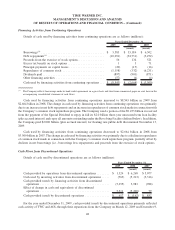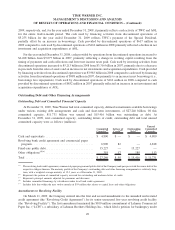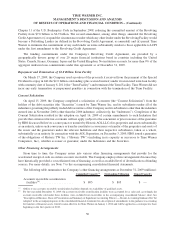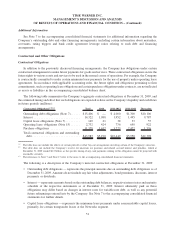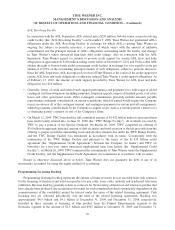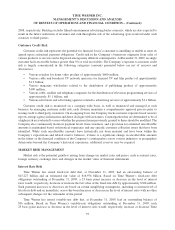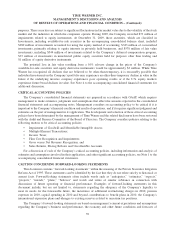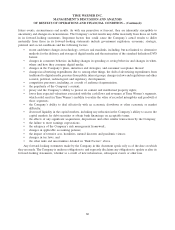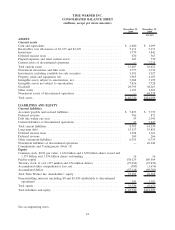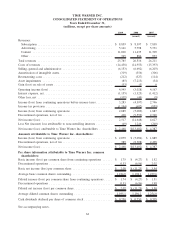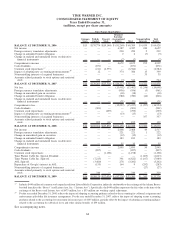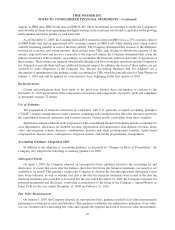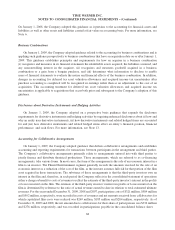Time Magazine 2009 Annual Report Download - page 70
Download and view the complete annual report
Please find page 70 of the 2009 Time Magazine annual report below. You can navigate through the pages in the report by either clicking on the pages listed below, or by using the keyword search tool below to find specific information within the annual report.
Warner’s annual interest expense and related cash payments by an insignificant amount. Such potential increases or
decreases are based on certain simplifying assumptions, including a constant level of variable-rate debt for all
maturities and an immediate, across-the-board increase or decrease in the level of interest rates with no other
subsequent changes for the remainder of the period. Similarly, since almost all of the Company’s cash balance of
$4.800 billion is invested in variable-rate interest-earning assets, the Company would also earn more (less) interest
income due to such an increase (decrease) in interest rates.
From time to time, the Company may use interest rate swaps or other similar derivative financial instruments to
hedge the fair value of its fixed-rate obligations or the future cash flows of its variable-rate obligations. At
December 31, 2009, there were no interest rate swaps or other similar derivative financial instruments outstanding.
Foreign Currency Risk
Time Warner uses foreign exchange contracts primarily to hedge the risk that unremitted or future royalties and
license fees owed to Time Warner domestic companies for the sale or anticipated sale of U.S. copyrighted products
abroad may be adversely affected by changes in foreign currency exchange rates. Similarly, the Company enters
into foreign exchange contracts to hedge certain film production costs abroad as well as other transactions, assets
and liabilities denominated in a foreign currency. As part of its overall strategy to manage the level of exposure to
the risk of foreign currency exchange rate fluctuations, Time Warner hedges a portion of its foreign currency
exposures anticipated over the calendar year. The hedging period for royalties and license fees covers revenues
expected to be recognized during the calendar year; however, there is often a lag between the time that revenue is
recognized and the transfer of foreign-denominated cash back into U.S. dollars. To hedge this exposure, Time
Warner uses foreign exchange contracts that generally have maturities of three months to eighteen months and
provide continuing coverage throughout the hedging period. At December 31, 2009 and 2008, Time Warner had
contracts for the sale of $2.320 billion and $1.840 billion, respectively, and the purchase of $1.762 billion and
$2.234 billion, respectively, of foreign currencies at fixed rates. The following provides a summary of foreign
currency contracts by currency (millions):
Sales Purchases Sales Purchases
December 31, 2009 December 31, 2008
(recast) (recast)
British pound .................................. $ 684 $ 519 $ 682 $1,027
Euro......................................... 482 243 402 332
Canadian dollar ................................ 484 338 311 265
Australian dollar ................................ 331 419 199 315
Other ........................................ 339 243 246 295
Total ........................................ $2,320 $1,762 $1,840 $2,234
Based on the foreign exchange contracts outstanding at December 31, 2009, a 10% devaluation of the
U.S. dollar as compared to the level of foreign exchange rates for currencies under contract at December 31, 2009
would result in approximately $56 million of net unrealized losses. Conversely, a 10% appreciation of the
U.S. dollar would result in approximately $56 million of net unrealized gains. For a hedge of forecasted royalty or
license fees denominated in a foreign currency, consistent with the nature of the economic hedge provided by such
foreign exchange contracts, such unrealized gains or losses largely would be offset by corresponding decreases or
increases, respectively, in the dollar value of future foreign currency royalty and license fee payments that would be
received in cash within the hedging period from the sale of U.S. copyrighted products abroad. See Note 13 to the
accompanying consolidated financial statements for additional discussion.
Equity Risk
The Company is exposed to market risk as it relates to changes in the market value of its investments. The
Company invests in equity instruments of public and private companies for operational and strategic business
58
TIME WARNER INC.
MANAGEMENT’S DISCUSSION AND ANALYSIS
OF RESULTS OF OPERATIONS AND FINANCIAL CONDITION – (Continued)


